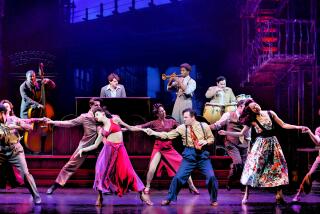New York Intellect by Thomas Bender (Knopf: $25; 422 pp.)
Thomas Bender has large ambitions for “New York Intellect.” He states in the preface, “We cannot understand ourselves as intellectuals, as Americans, until we grasp the special character of New York--both its possibilities and its limitations--as a place of intellect.” The identification of a city with an aspect of its life has proved a profitable line of inquiry. Studies as diverse as Carl Schorske’s “Fin-De-Siecle Vienna,” Roger Shattuck’s “The Banquet Years” and Reyner Banham’s “Los Angeles” have all accomplished what Bender desires to do for New York. In each book, a fundamental aspect of place becomes an emblem for the city as a whole. Schorske’s analysis of Vienna’s Ringstrasse, Shattuck’s Parisian avant-garde artists and Banham’s treatment of Los Angeles architecture dramatized the essential qualities of the larger urban culture. Unfortunately, Bender cannot quite locate New York’s core.
The book compensates for its lack of center by becoming more or less a conventional social and cultural history of the city from 1750 to about the present. As such, it is a useful reference source. Particularly helpful are discussions of commonly neglected figures like Randolph Bourne, who, before World War I, represented the model New York mind by combining a concern for art with the “particulars of contemporary life,” and Herbert Croly, who, as founder of The New Republic (1914) and earlier as editor of the Architectural Record, wrote consistently on the “problem of intellectual and artistic excellence in a commercial society.” Bender considers others like William Crary Brownell, mandarin “literary adviser” at Charles Scribner’s Sons publishers, and Richard Watson Gilder, editor of The Century magazine, as examples of an older breed whose class-bound “standards” young intellectuals were challenging at the turn of the century.
In addition to these useful profiles, the book unfortunately swells with predictable references to well-established and frequently studied figures like Walter Lippmann, Edmund Wilson and Lewis Mumford. Also there are inexplicable omissions. Kenneth Burke, now in his 90th year and a critical voice of the period, is not even mentioned. In trying frantically to find a pattern, a telling line of argument or a hook, Bender often loses his subject--and his reader.
Lacking any convincing or compelling narrative, the book is scrupulous about facts less accessible elsewhere. Bender demonstrates that New York, like other 18th-Century cities, was a beneficiary of cultural diversity, first manifested by the general shift of population away from the country. In 1754, King’s College (now Columbia University) and the New York Society Library were founded. In the same year, the Royal Exchange, an elaborate piece of pre-Revolutionary public architecture, was completed. By then, the city could already boast impressive developments in learning and the arts and could assume “self-consciousness as an 18th-Century provincial city.” A lively intellectual life was supported by professional men, particularly in law and medicine. William Livingston was typical of the former. Born to a wealthy Albany family and educated at Yale, he typified the enlightened patrician New Yorker of the day. “While not a complete democrat or an unambiguous proponent of merit, he insisted that social honor and power should not be associated only with wealth.”
Livingston wanted the larger culture of New York to mediate between the raw energies associated with the pioneers and the cultivation of a small educated elite. He rejected the idea that knowledge should be compartmentalized in separate institutions and did not prefer abstractions over practical knowledge. Livingston and Samuel Bard, his counterpart in medicine and founder in 1771 of New York Hospital, did not associate intellect solely with the academy. Bender is correct in arguing that from the city’s beginnings as a center for ideas, the town/gown conflict never displaced the city as a magnet for non-academic intellectuals. Early on, the city supported many learned circles or clubs and displayed a willingness to embrace intellectual diversity.
A pattern recognizable today developed early. New York would be secular, not religious; it would be social, not academic, and it would find ideas predominantly outside the university. Not until the end of World War II did professors successfully compete for an audience with the Greenwich Village crowd, typified by the Partisan Review.
As exclusive or refined as New York intellectual life became in this century, the price of admission was never a Ph.D. Rather, required was a certain boldness and an ability to dramatize ideas. Saul Bellow still lives in Chicago but made his reputation in New York. Delmore Schwartz, poet and critic, moved downtown, as later did Allen Ginsberg, and both found a rich environment for their work, as had Herman Melville and Walt Whitman a century earlier. There was a life in the streets that inspired literature and a collection of bookstores, funky clubs and oddballs that nourished it. The instinct to support what the Masons called the “propagation of knowledge” served the city well by broadening its intellectual base through its free institutions, most notably the Public Library and City University, and by encouraging a steadily changing immigrant population to enrich its culture.
The arrival of people from all over the world was met by a consistent internal migration of artists, drawn to the city by its concentration of galleries, theaters, concert halls and clubs. From the 19th Century on, New York was really too vast to achieve a single identity. “The city had become multiple environments, unknown to each other and, perhaps, unknowable through direct or personal experience.” Bender accurately points out that a sense of coherence, a particular set of feelings associated with being a New Yorker, was accomplished through large-circulation newspapers. Later this image was refined by prestige magazines like Vanity Fair and The New Yorker. By encouraging life at the edges, New York has been, for almost 200 years, more than the commercial and banking center it started out to be. But the genius of the city has been to make art into business, a symbiosis that has sustained both. It has always followed its artists into business. The Bowery, SoHo, Tribeca, the Lower Eastside were all at one time artist ghettos. Artists looking for space and cheap rents moved farther downtown. Developers took their lead and have transformed formerly decayed areas into new gentrified residential districts, thus displacing once again all but the most successful artists and restarting the process of internal settlement.
Oddly, Bender is less sensitive to this revitalizing aspect of New York life than he is to certified accomplishments of figures like George Balanchine and Martha Graham. While he discusses poetry in the city, he completely neglects the more organic development of jazz. “New York Intellect” reveals a certain selectivity and inadvertent smugness. By focusing on accomplishments rather than the process of making ideas and art in New York, Bender misses the essence of the subject he so assiduously attempts to locate. Like Edgar Allan Poe’s purloined letter, the longed-for central idea is right in front of him, caught somewhere inside the mountain of facts and numbing detail. New York is extraordinary, not only for what it finally accomplishes and celebrates unapologetically in front of the rest of the world, but also for the fact that the process still works. The tension between art and commerce, professional and academic still produces a dynamic and changing culture worth all the celebration.
More to Read
Sign up for our Book Club newsletter
Get the latest news, events and more from the Los Angeles Times Book Club, and help us get L.A. reading and talking.
You may occasionally receive promotional content from the Los Angeles Times.






